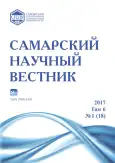The spiritual and educational activities of the Tatars in the Kazakh Steppe in the context of the Russian Empire’s domestic policy (second half of XVIII – the beginning of XX century)
- Authors: Makhmutov Z.A.1
-
Affiliations:
- Sh. Mardjani Institute of History of Academy of Sciences of Republic of Tatarstan
- Issue: Vol 6, No 1 (2017)
- Pages: 113-117
- Section: 07.00.00 – Historical Sciences and Archaeology
- URL: https://journals.rcsi.science/2309-4370/article/view/21652
- DOI: https://doi.org/10.17816/snv201761206
- ID: 21652
Cite item
Full Text
Abstract
This paper discusses the spiritual and educational activities of the Tatars in Kazakh’s steppe in pre-revolutionary period. The Empress Catherine II let mass penetration of the Tatar mullahs into the steppe zone. They performed some of the functions of the tsar officials in addition to religious and educational activities. They completed parish registers and directed civil proceedings. The Tatar language became the main language of the clerical work in the steppe zone. After the Crimean and Caucasian war the attitude of imperial administration to the activities of Tatar preachers changed dramatically. Since that time, Islam and Muslim education in the Steppe zone started to be considered by officials as a threat to the Russian state. The Russian government limited the powers of the mullahs, subdued Muslim schools to the Ministry of Education and strictly regulated it, tried to introduce the Russian language into the mosques and madrasas. Minister of Internal Affairs through its secret messages made local administration offices translate clerical works from the Tatar language on Arab ligature to the «missionary» Kazakh language on Cyrillic alphabet. It was also strongly recommended to replace Tatar interpreters to Kazakh or Russian ones. Despite the internal policy of the Russian state had changed, the Tartars built powerful spiritual and educational infrastructure in the Steppe zone. At the beginning of the XX century it included the old and new madrasas, mosques, Muslim Library and publishing houses. In Muslim schools prominent people of Tatar and Kazakh culture were educated, first books and newspapers in both languages were issued in theses publishing houses. The spiritual and educational activity of the Tatars played a significant role in the formation of the Kazakh and Tatar intelligentsia and led to the rise of religious and political consciousness of both nations.
Full Text
##article.viewOnOriginalSite##About the authors
Zufar Alexandrovich Makhmutov
Sh. Mardjani Institute of History of Academy of Sciences of Republic of Tatarstan
Author for correspondence.
Email: zufar@inbox.ru
candidate of historical sciences, senior researcher
Russian Federation, KazanReferences
- Султангалиева Г.С. Татарская диаспора в конфессиональных связях казахской Степи (XVIII–XIX вв.) // Вестник Евразии 2000. № 4. С. 20–36.
- Хайруллин Г.Т., Хамидуллин А.Г. Татары Алматы: Билим, 1998. 128 с.
- Франк А. Татарские муллы среди казахов и киргизов в XVIII–XIX веках // Культура, искусство татарского народа. Казань, 1993. С. 124–132.
- Лысенко Ю.А. «Татарский вопрос» в конфессиональной политике Российской империи в Казахстане (конец XVIII – начало ХХ в.) // Известия Алтайского государственного университета. 2010. № 3–4. С. 146–152.
- Любичанковский С.В. Поддержка ислама среди казахов как государственная политика дореформенной России (XVIII – середина XIX вв.) // Кадырбаевские чтения – 2016: мат-лы V междунар. науч. конф. Актобе, 2016. С. 74–79.
- Горбунова С.В. Государственная регламентация религиозной жизни казахов в Российской империи // Вестник Нижневартовского государственного университета. 2008. № 1. С. 35–41.
- Ремнев А.В. Татары в казахской Степи: соратники и соперники Российской империи // Вестник Евразии. 2006. № 4. С. 5–32.
- Тажибаев Т. Просвещение и школы Казахстана во второй половине XIX века. Алма-Ата: КГИ, 1962. 507 с.
- Халитова И.Р. Проблемы народного образования в Казахстане в 1867–1914 гг.: дис. … канд. ист. наук. Алма-Ата, 1992. 174 с.
- Раздыкова Г.М. Этнический компонент в мусульманском образовании казахов Степного края в конце XIX – начале XX вв.: дис. … канд. ист. наук. Павлодар, 2007. 194 с.
- Полное собрание законов Российской империи (ПСЗРИ). СПб., 1830. Т. XXII. № 16292, № 16534.
- Центральный государственный архив Республики Казахстан (далее – ЦГАРК). Ф. 15. Оп. 2.
- Хрестоматия по истории педагогики. М., 1936. Т. IV. 526 с.
- Полное собрание законов Российской империи (ПСЗРИ). Т. XXXXIX. Ч. 2. СПб., 1876. 496 с.
- Государственный архив Омской области. Ф. 3. Оп. 9.
- ЦГАРК. Ф. 25. Оп. 1.
- ЦГАРК. Ф. 90. Оп. 1.
- Храпченков Г.М. Школы Казахстана в начале XX века (1901–1917 гг.): дис. … канд. пед. наук. Алма-Ата. 1963. 248 с.
- Храпченков Г.М. История школы и педагогической мысли Казахстана. Алматы, 1998. 168 с.
- Лысенко Ю.А. Степень исламизации казахского общества на рубеже конца XIX – начала ХХ в. в оценках миссионеров Киргизской духовной миссии // Известия Алтайского государственного университета. 2008. № 3–4. С. 149–155.
- ЦГАРК. Ф. 64. Оп. 1.
- ЦГАРК. Ф. 369. Оп. 1.
- Каримуллин А.Г. Татарская книга начала XX века. Казань, 1974. 307 с.
- Государственный архив Российской Федерации Ф. 1701. Оп. 1.
Supplementary files






